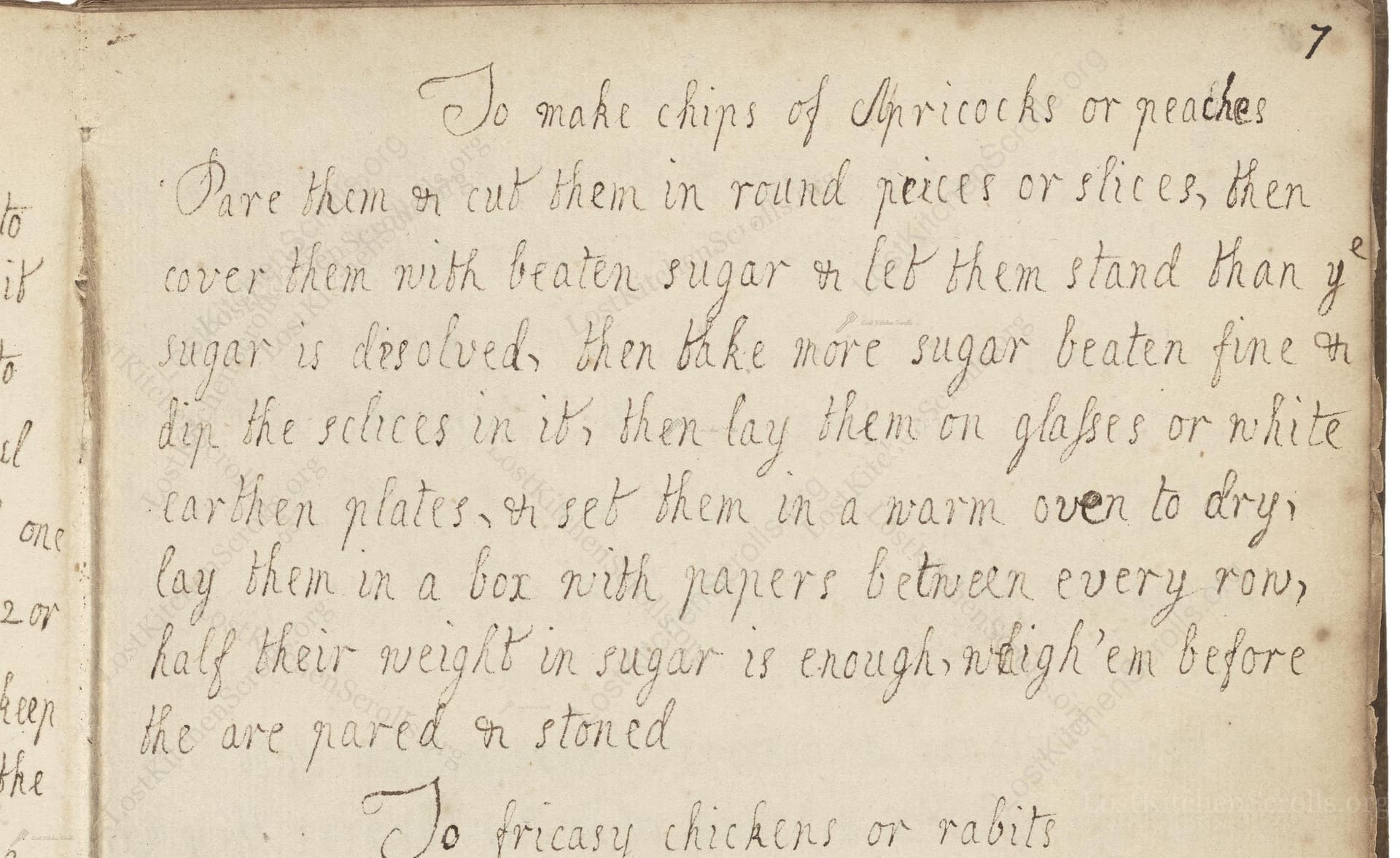To Make Chips Of Apricocks Or Peaches
From the treasured pages of Cookbook of 1720
Unknown Author

To Make Chips Of Apricocks Or Peaches
"Pare them or cut them in round peices or slices, then cover them with beaten sugar & let them stand than ye sugar is desolved, then take more sugar beaten fine & dip the sclices in it, then lay them on glasses or white earthen plates, or set them in a warm oven to dry, lay them in a box with papers between every row, half their weight in sugar is enough, weigh'em before the are pared & stoned"
Note on the Original Text
The recipe is written in the straightforward, conversational style typical of early 18th-century cookery, assuming the reader has basic domestic skills and access to the ingredients and equipment of a genteel kitchen. Spelling is outdated and idiosyncratic ('Apricocks' for 'apricots', 'ye' for 'the'). Quantities are given relative to the fruit’s weight before processing, a common practice in historical fruit preserving.

Title
Cookbook of 1720 (1720)
You can also click the book image above to peruse the original tome
Writer
Unknown
Era
1720
Publisher
Unknown
Background
Step back to the early 18th century and discover a delightful treasury of recipes and culinary secrets, where traditional flavors meet timeless technique—a feast for curious cooks and history lovers alike.
Kindly made available by
Folger Shakespeare Library
This recipe hails from the early 18th century, around 1720, an era when refined sugar was both a delicacy and a preserving agent. England was in the midst of a culinary transformation, with imported fruits and sugar becoming more available to the well-off. Preserved fruits such as these 'chips' were prized for winter treats and elegant desserts. The instructions reflect a time before modern canning or refrigeration, relying on sugar and drying to extend the shelf life of delicate summer produce.

Cooks of the period would have used a sharp paring knife for peeling and slicing the fruit, a balance scale for weighing the ingredients, and mortars and pestles for grinding sugar to a fine powder. Slices were laid on glass plates or glazed white earthenware and dried in the gentle warmth near the mouth of a wood-fired oven or over a hearth.
Prep Time
20 mins
Cook Time
5 hrs
Servings
12
We've done our best to adapt this historical recipe for modern kitchens, but some details may still need refinement. We warmly welcome feedback from fellow cooks and culinary historians — your insights support the entire community!
Ingredients
- 2.2 lbs fresh apricots or peaches (before peeling and stoning)
- 1.1 lbs caster sugar (granulated can be used as a substitute)
- Additional parchment or wax paper for storage
Instructions
- Begin by peeling and slicing fresh apricots or peaches into rounds.
- Weigh the fruit before removing the kernels or pits—you’ll need half that weight in sugar.
- Layer the fruit slices with about half of the sugar (finely ground or caster sugar works best), and let them sit until the sugar dissolves, drawing out some juices.
- Take the remaining sugar and spread it on a plate.
- Dip each syrupy fruit slice into this dry sugar to coat.
- Arrange the sugar-coated slices in a single layer on baking trays lined with parchment paper or silicone mats (traditionally, glass or ceramics were used).
- Place the trays in a warm oven—about 140–175°F (60–80°C), or use a dehydrator, until the slices are dry and firm but still slightly chewy.
- Once cooled, store the slices in a tin or airtight box, with baking parchment or wax paper between each layer to prevent sticking.
Estimated Calories
120 per serving
Cooking Estimates
Preparation takes about 20 minutes, mainly for peeling and slicing the fruit and coating in sugar. Drying the fruit in the oven takes 4 to 6 hours, depending on thickness and juiciness. Each serving has about 120 calories if you divide the whole recipe into 12 portions.
As noted above, we have made our best effort to translate and adapt this historical recipe for modern kitchens, taking into account ingredients nowadays, cooking techniques, measurements, and so on. However, historical recipes often contain assumptions that require interpretation.
We'd love for anyone to help improve these adaptations. Community contributions are highly welcome. If you have suggestions, corrections, or cooking tips based on your experience with this recipe, please share them below.
Join the Discussion
Rate This Recipe
Dietary Preference
Main Ingredients
Culinary Technique

Den Bockfisch In Einer Fleisch Suppen Zu Kochen
This recipe hails from a German manuscript cookbook compiled in 1696, a time whe...

Die Grieß Nudlen Zumachen
This recipe comes from a rather mysterious manuscript cookbook, penned anonymous...

Ein Boudain
This recipe comes from an anonymous German-language manuscript cookbook from 169...

Ein Gesaltzen Citroni
This recipe, dating from 1696, comes from an extensive anonymous German cookbook...
Browse our complete collection of time-honored recipes



